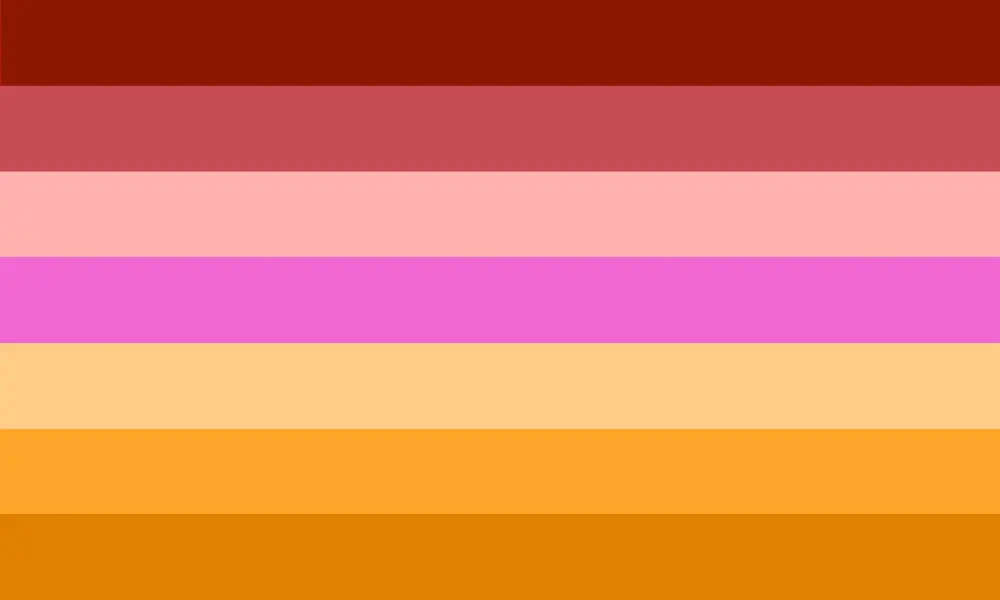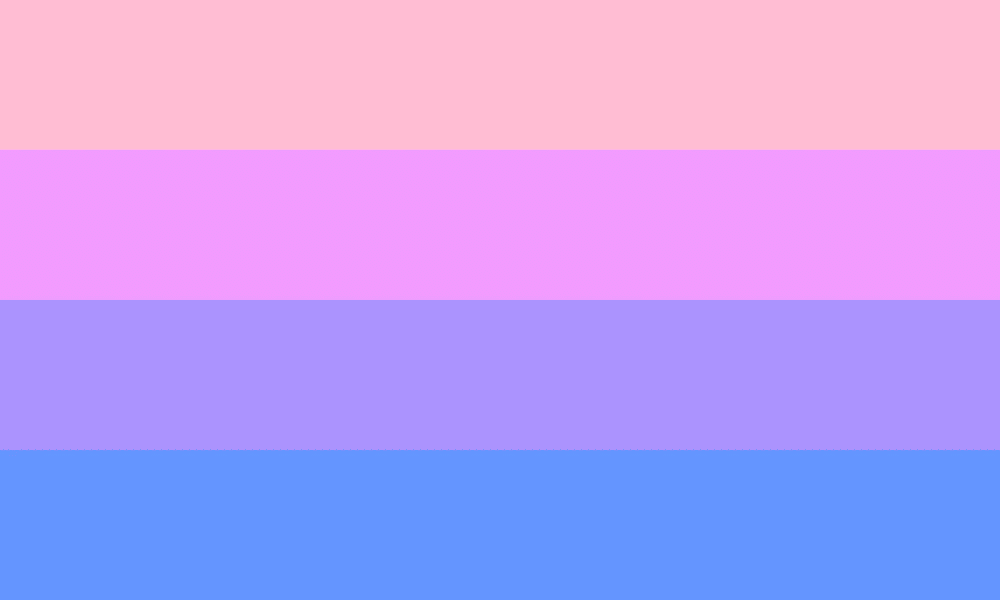Gynesexual – What is it? What does it mean?
 Gynesexual flag
Gynesexual flag
Gynesexuality, or gynosexuality, describes the sexual orientation of people who are attracted to femininity, feminine qualities, or someone who identifies as female. As opposed to, for example, someone who is homosexual or heterosexual, gynosexuality does not describe the gender identity of the person to whom sexual attraction is experienced, but rather their presentation. The Urban Dictionary has the following definition on its site: “Someone that is sexually attracted to feminine individuals, or woman, or people that “look” like a woman.”
Table of Content
Gynosexual is a fairly new word that is used to describe attraction to feminine traits. Although the word can be applied to anybody, it’s often used to describe people who fall outside of the gender binary. Here’s a deep dive into what it means to be gynosexual, and the history of the term.
Terminology
Here’s a more detailed definition of gynosexual (sometimes gynesexual) along with some other terms that may be helpful to know.
Gynosexuality
Gynosexuality refers to the sexual orientation of a person who is sexually attracted to femininity regardless of their gender identity or the gender identity of the other person. Gyno is a Greek word that means woman or female. It’s a relatively new term created to better describe sexual attractions that don’t necessarily fit into previously existing words.
For example, imagine a nonbinary person who was assigned male at birth and is attracted to femininity. They may not feel comfortable being identified as straight, but a word like gynosexual fits.
It’s also important to understand that the attraction is to what the gynosexual perceives as feminine characteristics, not female gender or sexuality. A person who is gynosexual may be attracted to feminine attributes in cis or trans women. Some are sexually attracted to men who have feminine traits.
Gynephilic
An alternative word for gynosexual or gynesexual.
Feminine Traits
What does it mean when someone refers to sexual attraction to feminine traits? That can be subjective. Like other attractions, gynosexual people are individuals with their own interpretations on what femininity means. Many have an attraction to female genitalia and breasts. Other attributes that gynosexual people identify with being feminine might include curvy hips, a higher-pitched voice, softer facial features, and feminine dress. People of any gender identity can have these characteristics just like people who identify as androsexual can identify as any gender.
There are also emotional and psychological traits that people often associate with women in addition to physical attributes. An attraction to women or femininity might include being drawn to people who are sensitive, tender, or nurturing. A person may identify as gynephilic when they experience any combination of desire for emotional, physical, or psychological traits that they perceive as being feminine.
Androsexual People
Androsexuality means sexual attraction to masculinity vs. attraction women or femininity. It’s a word that was created with the same concept as gynesexual. The key difference is that the person’s attraction is to attributes they associate with masculinity regardless of whether the person they are with was assigned male at birth or not.
Gay
This word refers to a sexual orientation of attraction to men by men. When used in a gynosexual context, it relates to attraction to femininity in men. So, a gynosexual man with this sexual attraction is drawn to feminine features displayed by cis or transgender men.
Heterosexual
A person who is attracted to the opposite gender. In this case, they would be specifically drawn to feminine people.
Lesbian
A lesbian gynosexual is attracted to feminine women.
Bisexual
A bisexual who also identifies as gynosexual is attracted to femininity whether those traits are being presented by a man or woman.
Gender Identity

credit: verywellmind.com
Gender identity is someone’s deeply personal perception of their own gender. They may identify as non-binary, man, or woman. A person can identify as any gender and be attracted to femininity. They may also find those traits within men, women, or non-binary people.
Sexual Orientation
Sexual orientation is an individual’s ongoing attraction to a specific group or groups of people based on gender. It may also refer to an absence of that in the case of those who are asexual or aromantic. Orientation goes beyond sexual feelings in many case. People often feel a strong sense of personal identity and community belonging as it applies to their sexual orientation.
Sexual Attraction
This describes feelings of interest and arousal to others based on qualities they possess. Contextualized within the framework of gynosexuality, this refers to femininity as the desired trait.
History
There isn’t much in-depth history when it comes to the term gynosexual. It’s only been added to common LGBTQIA+ terminology recently. As mentioned previously, it has Greek roots, but was coined for contemporary usage. It was adopted to provide a more nuanced description of attraction to femininity that doesn’t fit neatly into traditional categories such as heterosexual.
Evolution of LGBTQIA+ Language as an Identifying Tool
As we gain a greater understanding of gender and sexuality, there’s an evolving need for new words and phrases. This is why terms like gynosexual and androsexual have emerged in the past decades. They allow people to better express themselves, and use more inclusive language.
Use in Academic And Social Contexts
The word is also used in academic spaces, particularly in the areas of psychology, gender studies, and sociology. Like many words that define things that are related to queerness, social use of gynosexuality and androsexuality are most common in LGBTQIA+ spaces. However, mainstream use is increasing as people seek out better ways to express that they are attracted to specific characteristics. The word now appears in online publications such as Verywell Mind and Urban Dictionary.
Flags and Symbols
Symbols and flags allow people to express pride and support. More importantly, they provide a tangible, physical means through which people can show support or identify with this group.
Gynosexual Pride Flag Gynesexual flag
Gynesexual flag
Although there is a gynesexual flag, there is currently no universally used symbol for gynesexuality. Maybe you have any ideas?
Pronouns
Being gynosexual says something about your sexuality. As you probably know, gender and sexuality are not necessarily connected, and should not be seen as such. Anyone of any gender can be gynesexual, so there are no particular pronouns, just as there are no particular pronouns for bisexuality. It should, however, be noted that labels such as gynesexual and gyneromantic are often used by people who identify as non-binary or genderqueer, so to promote a healthy environment, always be mindful of which pronouns you use!
Am I a Gynosexual?
![]()
What makes you interested in romantic and sexual relationships with other people. If you are aroused or attracted to traits that you consider to be femme or associate with women, you might be gynesexual. It’s up to you whether you resonate with this term or prefer something else. Often, people use this term if they are trans masc or nonbinary, and don’t feel comfortable using the word straight or hetero to self describe.
How to Support a Gynosexual
You support someone who identifies as gynesexual in the same way you would a person with any other identity or orientation. You simply accept their right to self-definition. Listen to them if they choose to share their feelings and experiences. Offer emotional support if they seem to be struggling.
The most important thing is to remember that this is something each person defines for themselves, and can include being drawn to a wide range of physical characteristics, biological sex traits, and psychological attributes. It is not limited to people who are biological females.
Gallery
These are some of the alternate versions of the gynosexual flag, along with related flags:
 The original gynosexual flag
The original gynosexual flag
 Alternate version of this flag
Alternate version of this flag
 Alternate gynesexual flag by ThatOneKnows
Alternate gynesexual flag by ThatOneKnows
 Alternate gynesexual flag by QueerVexillology
Alternate gynesexual flag by QueerVexillology
 Alternate gynesexual flag by ThunderBrine
Alternate gynesexual flag by ThunderBrine
Resources
https://www.health.com/mind-body/health-diversity-inclusion/gynesexual
https://lexicon.library.lgbt/wordgrouping/sexuality/
https://flag.library.lgbt/flags/gynesexual/
https://flag.library.lgbt/wp-content/uploads/sites/6/2021/06/Gynesexual.png
Share this post:
What do you think?
 Gynesexual flag
Gynesexual flag


